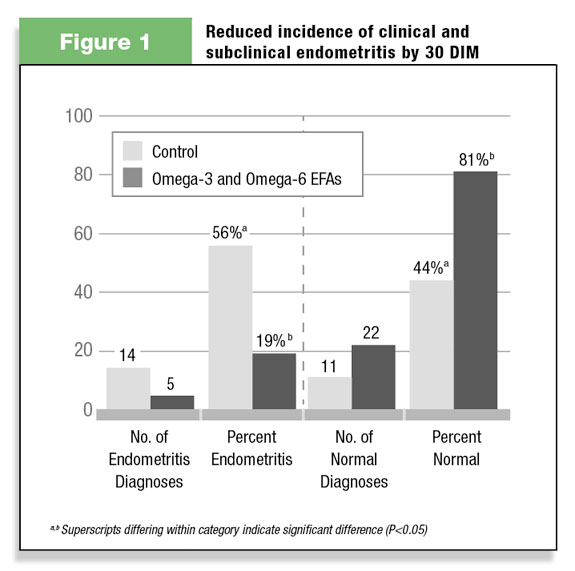Reproductive performance starts long before the cow is confirmed pregnant. While producers rely on metrics to evaluate their reproduction program, many factors – like nutrition, environment and health – directly contribute to an animal’s ability to conceive and maintain the pregnancy. One factor that continues to have direct impact on herd performance and profitability is uterine health.
Why uterine health?
The prevalence of and financial losses related to uterine diseases like metritis are staggering. Research has shown that one case of metritis can cost the dairy as much as $354, and subclinical metritis can impact as much as 20 percent of the herd. This could translate to a loss of as much as $70,000 per year for a 1,000-cow dairy from metritis infections alone.
The cost to producers is mainly due to lost milk production and treatment costs. If the animal doesn’t respond quickly to treatment, metritis can also lead to additional milk loss throughout the lactation as well as delays in future breedings.
While monitoring onset of metritis can help identify new cases early, subclinical cases often go unnoticed and may, according to leading industry researchers, affect as much as half of your herd. The most successful way to handle both subclinical and clinical forms of the disease is to proactively avoid the uterine disease altogether.
Nutrition matters
Uterine health is impacted by many different variables, from environmental factors to the ration. One proven tool to help reduce the incidence of endometritis is through proper ration formulation with Omega-3 and Omega-6 essential fatty acids (EFAs).
Rumen bypass sources of EFAs deliver these nutrients to the small intestine where they can be absorbed and utilized for reproductive health. Omega-3 and Omega-6 are the only EFAs proven to improve reproductive performance.
Cows cannot naturally produce Omega-3 and Omega-6, though they are vital for sound uterine health and reproductive success. These EFAs can be found in feedstuffs like roasted soybeans, whole cottonseed and flaxseed, but are altered in the rumen before they can be absorbed.

These specific EFAs have also led to on-farm improvements in uterine health. Research conducted on a large commercial dairy by the University of Arizona compared the reproductive health and performance between cows fed a control diet versus cows fed EFAs in the treatment diet. Both diets were fed three weeks prepartum through confirmed pregnancy.
Endometritis was diagnosed by taking uterine swabs and monitoring bacterial activity in the uterus. The research study found:
• Clinical cases of metritis were seen in 4.5 percent of control cows versus zero animals in the treatment group.
• 56 percent of cows in the control group were diagnosed with endometritis – meaning they had some kind of uterine infection – versus 19 percent in the treatment group. That’s a 66 percent reduction for the cows fed EFAs!
Based on the number of clinical and subclinical cases diagnosed in both groups, researchers concluded that feeding EFAs improved uterine health status of animals in the trial.
Healthier animals are also able to cycle and conceive sooner. In the same study, researchers found cows fed Omega-3 and Omega-6 EFAs:
• Returned to normal ovarian activity faster. Cows fed Omega-3 and Omega-6 EFAs resumed cyclicity earlier and experienced more ovulatory cycles by 60 days in milk (DIM).
• Experienced more pregnancies sooner. By 175 DIM, 70 percent of cows fed Omega-3 and Omega-6 EFAs were confirmed pregnant, while only 40 percent of the control group were pregnant.
A full-circle approach to uterine health
Alongside proven nutrition benefits, managing cows to reduce the incidence of uterine infections should remain top-of-mind for producers.
• Keep transition a top priority. How well cows join the milking herd will directly impact their performance and, ultimately, uterine health. Together with your nutritionist, keep cows eating throughout this six-week period, monitor behavior and identify cows that need additional assistance early to minimize new uterine health infections.
• Assess uterine health routinely. Effectively measuring uterine health on your dairy can be a challenge, but is the first step to prevent further infections that have long-term impact on performance. Work with your veterinarian to determine the best way to monitor the disease and treat cases early.
• Bring together a team of consultants. With a direct impact to your bottom line, uterine health should remain a top priority for you and your consultants.
Work with the team – including both your nutritionist and veterinarian – to review uterine health protocols and make adjustments to uterine health monitoring as changes in incidence are recognized.
Maintaining uterine health through all stages of the life cycle has many positives for your dairy. A properly balanced ration harnessing the benefits of EFAs can help reduce the incidence of metritis, leading to reduced vet costs, increased milk production and improved pregnancy rates, translating to healthier cattle for maximized profit potential. PD
References omitted due to space but are available upon request to editor@progressivedairy.com .

-
Elliot Block
- Senior Manager of Technology
- Arm & Hammer Animal Nutrition
- Email Elliot Block






